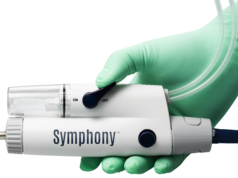Endovenous radiofrequency ablation is effective in the treatment of large diameter varicose veins irrespective of anatomical structure, according to a study presented by Andrey Petukhov, Research Institute of Experimental Medicine, Saint Petersburg, Russia, at the 13th Meeting of the European Venous Forum (Florence, Italy, 28-30 June 2012).
Petukhov told delegates that endovenous radiofrequency obliteration with the ClosureFast device (Covidien) has been widely used, however, “Its efficacy when dealing with veins of large diameter has remained the subject of discussion,” he said. Hence, Petukhov and colleagues set out to evaluate the effectiveness of the ClosureFast technology in the management of various large diameter vein trunks.
In the study, 110 patients (20% males and 80% females), median age of 41 years, underwent radiofrequency ablation between June 2009 and August 2011. The vein diameter criterion was no less than 1.3cm at the saphenofemoral junction. Thirty seven per cent of patients had trophic disturbances and 17% had a body mass index (BMI) above 30. The patients were followed up at three and 10 days and one, three, six and 12 months. Patients with lower limb ischaemia, musculoskeletal disorder and pronounced neurological disorders were excluded from the study.
Petukhov and colleagues identified anatomic variations of altered junctions from which 32.6% presented reflux in the greater saphenous vein, 8% in the small saphenous vein, 6% in the Giacomoni’s vein, 8% in the anterior branch of the greater saphenous vein and 28.5% in the extrafascial vein tract. “The identification of the pathologic types of junctions allowed for a tactical choice of initial point of intervention,” Petukhov noted.
Results
The study showed that, in 135 limbs treated, the total occlusion rate was 98%. There were no thermal skin or nerve injuries observed. Petukhov highlighted that there was no significant pain during and after the procedure (pain score from 0 to 10 was 0.8) and all patients resumed activity on the same day of the operation.
There were no cases of deep venous thrombosis reported, “We suppose the risks of deep venous thrombosis with radiofrequency ablation are overestimated,” said Petukhov.
There was no association between high BMI and increased risk of complications for what “radiofrequency ablation is the method of choice in patients with high BMI,” Petukhov commented.
Some side effects were reported including: hyperpigmentation in 7.5% of patients, erythema in 2% and haematomas in 20%.
Petukhov concluded: “Radiofrequency ablation meets all the requirements of safety specified for interventional surgical procedures. It may influence the quality of life in the rehabilitation period that could be prolonged in endovenous laser ablation and stripping procedures.”












